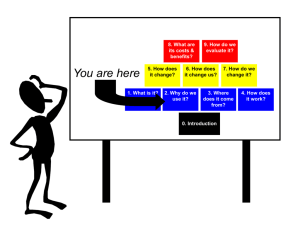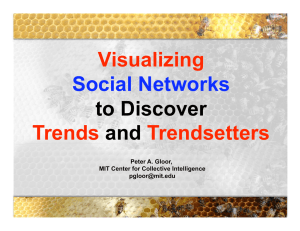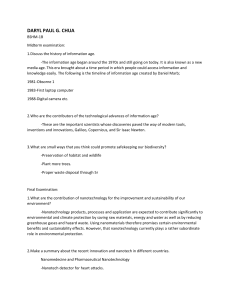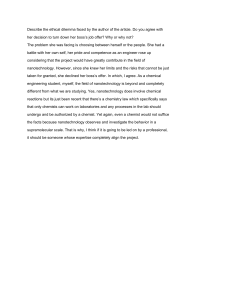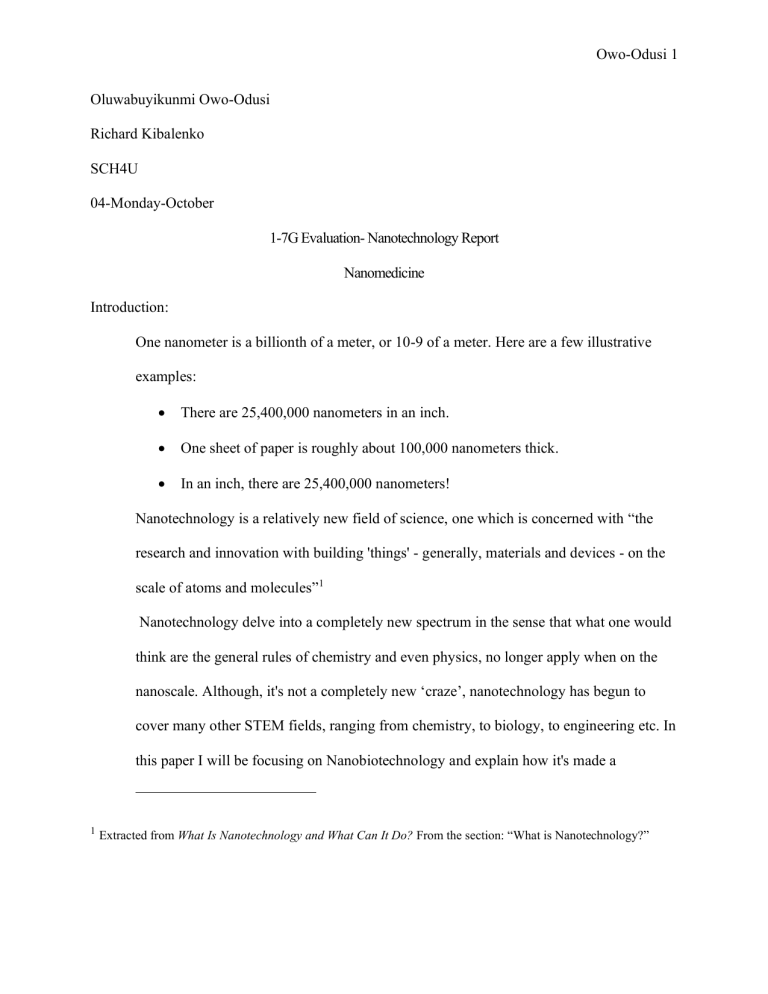
Owo-Odusi 1 Oluwabuyikunmi Owo-Odusi Richard Kibalenko SCH4U 04-Monday-October 1-7G Evaluation- Nanotechnology Report Nanomedicine Introduction: One nanometer is a billionth of a meter, or 10-9 of a meter. Here are a few illustrative examples: • There are 25,400,000 nanometers in an inch. • One sheet of paper is roughly about 100,000 nanometers thick. • In an inch, there are 25,400,000 nanometers! Nanotechnology is a relatively new field of science, one which is concerned with “the research and innovation with building 'things' - generally, materials and devices - on the scale of atoms and molecules”1 Nanotechnology delve into a completely new spectrum in the sense that what one would think are the general rules of chemistry and even physics, no longer apply when on the nanoscale. Although, it's not a completely new ‘craze’, nanotechnology has begun to cover many other STEM fields, ranging from chemistry, to biology, to engineering etc. In this paper I will be focusing on Nanobiotechnology and explain how it's made a 1 Extracted from What Is Nanotechnology and What Can It Do? From the section: “What is Nanotechnology?” Owo-Odusi 2 breakthrough in modern day medicine to link to Nanomedicine. Before I delve into that, it's important to highlight that Nanotechnology is still subject to debate on its efficiency and purpose. Nanotechnology is said to have massive potential to not only increase the efficiency of energy consumption but to also play an important role in helping clean the environment and all its biomes, as well as solving major health problems (a new one arising with the COVID-19 Pandemic). … Nanotech advocates claim that products of nanotechnology will be smaller, cheaper, lighter and yet still more functional and will require less energy and fewer raw materials to manufacture.” 2 However, “Activists worry that the science and development of nanotechnology will progress faster than policymakers can devise appropriate regulatory measures.” 3 , this'll then lead to dangerous, uncontrollable and possibly unethical technologies being created and such could create a whole new problem for the world coupled with the fact that most nanoparticles have the ability to accumulate in the environment thereby affecting food chains. But for now, I’ll take a look at Nanomedicine in the vast and rapidly changing world of medicine.’ Paraphrased from What Is Nanotechnology and What Can It Do? from the section: “What Can Nanotechnology Do?” 2 Extracted from What Is Nanotechnology and What Can It Do? from the section: “Concerns About Possible Effects on Human and Environmental Health”. Eric Drexler (the man who coined the term “Nanotechnology”) also speaks on this in his book Engines of Creation. 3 Owo-Odusi 3 Body: The image to the left4 shows the relationship between Nanobiotechnology and Nanomedicine along with other biotechnologies. “Nanotechnologies, by opening up the world beyond the microscale, will have a similar impact on medicine and surgery. This is because physiological and pathological processes at cell level occur on a nanoscale.”5 Ever since my dad was diagnosed with Type II Diabetes, it’s sort of been an area of interest for me on occasion. “Diabetes is caused by inability of the pancreas to control the blood glucose concentration. It is a pervasive, chronic and often insidious disease that affects 25.8 million people in the USA and nearly 285 million worldwide.” 6 For time, the oral administration of insulin has shown itself to not only be beneficial to the physical effects of insulin but now also the psychological effects as well. However, it has also faced many difficulties, from the breakdown of enzymes by the low pH of gastrointestinal fluids found in the stomach, to further degradation by other enzymes, 4 Image gotten from “Nanomedicine: Application of Nanobiotechnology in Medical Practice.” p.90. 5 From “Nanomedicine: Application of Nanobiotechnology in Medical Practice.” In comparison to the invention of the microscope and its effects on medicine, p.90. 6 Definition from “Nanomedicine for Diabetes Treatment.”, specifically from its first citation [1] Owo-Odusi 4 coupled with the fact that intestinal epithelium doesn’t allow for absorption of hydrophilic molecules (simply put: proteins, Polysaccharides etc.), they can't diffuse across the cells.7 Now this is where nanomedicine comes into play. Simply defined, nanomedicine is applying nanotechnology and possibly developing it to behave as a solution to modern day problems in medicine. “The nanomedicine technologies that may be employed for oral insulin delivery include prodrugs (insulin–polymer conjugation), micelles, liposomes, solid lipid nanoparticles (NPs) and NPs of biodegradable polymers.”8Among all those however, only most recently “a liposomal delivery system containing glycocholate as an enzyme inhibitor and permeation enhancer has been developed recently for oral insulin delivery, which showed better protection of insulin against enzymatic degradation by pepsin, trypsin and α-chymotrypsin”9 “To determine whether oral administration of CS NPs was associated with any toxicity in vivo, animals were treated with a daily dose of test NPs, which was 18-times higher than those used in the PD/PK study, for 14 days [22]. No significant differences in clinical signs (diarrhea, fever or other systemic symptoms) between the experimental group and the untreated control group were found, and no mortality occurred throughout the entire course of the study. Furthermore, no significant differences in body weight Paraphrased sentence from “Nanomedicine for Diabetes Treatment.” Also referred to as [5] in its citation list. 8 Extracted from “Nanomedicine for Diabetes Treatment.”. Continuing that statement, there is an example of a designed water-soluble, insulin derivative by Gershonov et al: [(2-Sulfo)-9fluorenylmethoxycarbonyl]3-insulin, p.1298. 9 Extracted from “Nanomedicine for Diabetes Treatment.” Written in comparison to “liposomes containing the bile salt counterparts of sodium taurocholate and sodium deoxycholate”. 7 Owo-Odusi 5 between the two studied groups were observed. The hematological and biochemical parameters measured in the experimental group were statistically comparable to those of the control group within their tolerable limits. Moreover, no pathological changes in liver, kidney and intestinal segments were microscopically observed. These results suggest that no apparent toxicity to the studied animals was found after oral administration of the CS NPs.”10 Oral insulin has given a new outlook to scientists on research for the treatment of diabetes; it has constantly shown its ability to revolutionize how it is administered. Still on the topic of diabetes, “For Type 2 diabetes, initial treatment focuses on delaying disease progression through exercise and regulation of meals”11 this is because without delaying said disease progression, hyperglycemia could cause blindness, kidney disease, heart disease, rapid nerve degeneration and increased susceptibility to opportunistic diseases. Hypoglycemia can also lead to seizures, unconsciousness or death. Molecular imaging and biomedical imaging tools are creating new opportunities for early diagnosis, staging and monitoring of disease progression for patients with type 1/2 diabetes. For example, under monitoring, with new kinds of glucose sensors which are coupled with nanoparticles engineered as transducers, the glucose-specific detecting molecules enable the design of new types of sensors that have the potential to be more patient-friendly, provide rapid measurements and improve precision.12 10 Research on whether oral administration of CS NPs is related to any sort of toxicity, extracted from “Nanomedicine for Diabetes Treatment.”, p. 1299 11 American Diabetes Association. Standards of medical care in diabetes — 2014. Diabetes Care 37, S14– S80 (2014). 12 Extracted from Scognamiglio, V. Nanotechnology in glucose monitoring: advances and challenges in the last 10 years. Biosens. Bioelectron. 47C, 12–25 (2013). Owo-Odusi 6 The image to the left shows an example of nanotechnology-based sensor technologies13 13 Image from “Managing Diabetes with Nanomedicine: Challenges and Opportunities.”. Fig.2b p. Owo-Odusi 7 Conclusion: Nanotechnology is a field bursting at the seams with exciting new technology waiting to be discovered. In as much as it could cause long term effects harmful to the environment such as accumulation of nanoparticles, it has also completely changed the way health is viewed in science and society today. Nanotechnology has allowed for further research into other means of glucose administration as well as better, faster and more user-friendly glucose sensors. I believe it’s a field that has so much to offer and I’m excited to learn so much more about it in the nearest future. Owo-Odusi 8 Works Cited 2005, Written by AZoNanoMar 5. “What Is Nanotechnology and What Can It Do?” AZoNano.com, 15 July 2013, www.azonano.com/article.aspx?ArticleID=1134. Jain, K.k. “Nanomedicine: Application of Nanobiotechnology in Medical Practice.” Medical Principles and Practice, vol. 17, no. 2, Feb. 2008, pp. 89–101., doi:10.1159/000112961. Sung, Hsing-Wen, et al. “Nanomedicine for Diabetes Treatment.” Nanomedicine, vol. 6, no. 8, 2011, pp. 1297–1300., doi:10.2217/nnm.11.124. Veiseh, Omid, et al. “Managing Diabetes with Nanomedicine: Challenges and Opportunities.” Nature Reviews Drug Discovery, vol. 14, no. 1, 2014, pp. 45–57., doi:10.1038/nrd4477.
